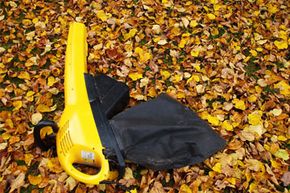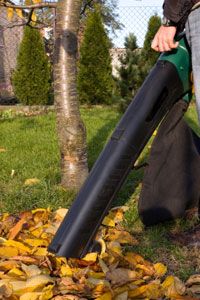 “Vacuuming up leaves and other plant debris is a more precise, less noisy way of cleaning up your lawn.©iStockphoto.com/vm
“Vacuuming up leaves and other plant debris is a more precise, less noisy way of cleaning up your lawn.©iStockphoto.com/vm
After going a couple of weeks without cleaning your kitchen floors, you notice they’ve become rather filthy. Bits of food are clustered close to the stove, fur from your shedding dog has collected under your kitchen table, and dust bunnies have started to form in the corners. But not to worry — you’ll make quick work of it. Grabbing a blow dryer out of your hall closet, you switch it on and direct the airstream toward the assembled filth. It’s a bit tricky, but with enough practice you’ll be able to blow all the dirt into a nice, manageable pile that you can sweep into the trash.
Or you could just use a vacuum cleaner. Blowing dirt around your house would be a little ridiculous, wouldn’t it? But for some reason, that line of thinking has rarely carried over to yard work. Homeowners may use suction to clean their living rooms, but outdoors they’ve had no problem chasing leaves into a pile, knowing full well that the slightest gust of wind could undo their afternoon of careful gathering.
Long a tool of professional landscaping companies, lawn and garden vacuums are slowly encroaching on leaf blowers as the yard cleanup tool of choice. Often resembling souped-up lawnmowers, lawn and garden vacuums are essentially larger, more rugged version of their indoor cousins. But where home vacuums will only be tackling dust, dirt and the occasional toenail, lawn and garden vacuums need to tangle with massive amounts of leaves and pine cones.
This means that lawn and garden vacuums are typically built more ruggedly, but the mechanics of both indoor and outdoor vacuums are about the same. At the center of the vacuum is a small compartment containing a high speed fan, which is connected to intake and exhaust hoses. As the fan spins, air is pushed out of the small compartment and into the exhaust fan. With the air pushed aside, a tiny, low-pressure area (known as a partial vacuum) is left behind in the compartment. Suction is created when air rushes in through the intake hose to fill this area, and leaves ride this jet of air just like a stream of water.
While push-mower varieties are the most common type of lawn and garden vacuum, they’re also offered in small handheld versions, large rideable models, or as trailer attachments to small-scale tractors. Backpack models are good for cleaning up bits of waste around trees and gardens, while larger, heavy-duty models can handle larger areas and ensure better pickup of debris.
So, how do you operate a lawn and garden vacuum?
How to Use Lawn and Garden Vacuums
 “Many lawn and garden vacuums will shred leaves, too.©iStockphoto.com/TZfoto
“Many lawn and garden vacuums will shred leaves, too.©iStockphoto.com/TZfoto
When using a lawn and garden vacuum, it’s best to think of your yard as a long, green shaggy carpet. Basically, all you need to do is push the machine slowly around the yard, and the suction takes care of the rest.
Just like an indoor vacuum, you’ll want to avoid bigger items, including branches, twigs and rocks, that can jam the machine. As you make your rounds of the yard, make sure that your path is clear of any large obstructions. Some lawn and garden vacuums even come with a miniature wood chipper mounted on the side, which will allow you to easily dispose of any stray twigs you encounter. You’ll also want to make sure the intake "snout" on your vacuum is properly adjusted to the terrain. When moving over long grass or bumpy terrain, raise the snout so that it won’t bump against the ground. If not, move the intake as close to the ground as possible. The smaller the distance between the intake and the ground, the greater the suction will be.
The most prominent feature of any lawn and garden vacuum is the collector bag. While lawnmowers can make do with a relatively tiny collector bag, lawn and garden vacuums come with bags as large as 12 cubic feet (0.34 cubic meter) designed to handle a much larger volume of waste. The collector bags are often too heavy and awkward for one person to lift and dump out, which is why most bags come with a clamped or zippered door to allow you to scoop out debris manually.
What if, rather than leaves and lawn clippings, your yard is strewn with plates and plastic forks from your kid’s birthday party? In some cases, lawn and garden vacuums will be powerful enough to suck up not only organic waste, but also glass, plastics and metal. But be sure to check the owner’s manual for your vacuum before you try tackling heavy-duty litter: If it turns out your machine can’t handle non-leaf material, you’ll want to make a good scan of your lawn before firing up your lawn vacuum. Like most yard equipment, you’ll want to avoid using your lawn and garden vacuum in the rain or soon after a storm. Leaves are harder to pick up when they’re soaked, and you’ll also end up sucking large amounts of water into the collector bag.
Before you purchase a lawn and garden vacuum, it’s a good idea to "test drive" one of the machines on familiar terrain. Head out to a local lawn and garden store and rent a vacuum for the weekend. If you like what you see, you can plunk down the cash for your own lawn and garden vacuum without worry. Some dealerships even offer "demonstration yards," where you can take a vacuum for a spin. Also, decide whether you need a wheeled machine or a portable, backpack-style vacuum. If you’re looking to clean leaves from between flower beds and other hard-to-reach areas, you’ll want the flexibility of a backpack-style machine. If, however, you’re looking to clean leaves from a backyard or a soccer field, you’ll want to pick something with wheels. Some backpack vacuums also come with the ability to function as a leaf blower, which may affect your choice.
Lawn and Garden Vacuum Equipment
 “You’ll need something to store all of the leaves you vacuum up.©iStockphoto.com/Orchidpoet
“You’ll need something to store all of the leaves you vacuum up.©iStockphoto.com/Orchidpoet
You wouldn’t hop into a canoe without a life jacket and paddle — similarly, there are a few pieces of equipment you’ll want to have handy before you fire up your lawn and garden vacuum.
All debris is not created equal, and that’s why most portable lawn and garden vacuums come with a range of nozzles and attachments to help you move into tight spaces. If you’re working in precise or delicate areas like a garden, you may want to avoid using a large intake nozzle that could end up doing damage. Or, if you’re picking up heavier debris, such as pine cones, you may want a smaller nozzle to give you more suction. Chances are your lawn and garden vacuum will come with all of the necessary equipment included. If not, specialty attachments should also be available through the manufacturer or your local home and garden center. If you’re using a push-variety lawn and garden vacuum, you may also be able to attach a large "wander" hose, giving you the flexibility to suck up stray bits of rubbish while makings the rounds of your backyard.
Lawn vacuums can sometimes be quieter than leaf blowers — but the fact remains that you’re usually dealing with a gasoline engine without a muffler. To avoid damaging your ears, pick up a pair of industrial earmuffs. In a pinch, foam or paper earplugs will do just as well. Ear protection won’t be necessary if you have the quieter (and cheaper) option of an electric vacuum, but you’ll want to make sure you have enough extension cords to move through the yard. Or, if you only have to use the device for about an hour at a time, you can also do away with the cord altogether and find yourself a cordless, battery powered machine.
Many larger varieties of lawn and garden vacuum will mulch waste as well as collect it. The result is that your yard waste will end up being much denser when you scoop it out of the machine’s collector bag. When you used a rake or a leaf blower, you may have filled six bags full of loose leaves. Now, you might find that you’re filling only two or three bags with mulch. Of course, the bags of mulch will be much heavier than the bags of leaves, which is why you’ll want to make sure you have extra-strong garbage bags if you’re planning on taking the mulch to the dump or leaving it on the curb for municipal pickup. Or, if you’re looking to reuse the mulch in your garden, make sure you have a large plastic garbage can to store it in.
For lots more information on lawn and garden care, see the links on the next page.
Lots More Information
Related Articles
- How to Mulch
- Tips to Creating Your Dream Yard
- What kind of yard never needs mowing?
- 10 Grasses for Your Yard
Sources
- Backyardandgardens.com. "The benefits of a commercial leaf vacuum." 2011. (April 14, 2011)http://backyardsandgardens.com/the-benefits-of-a-commercial-leaf-vacuum/
- Berendsohn, Roy. "Lawn and Garden Gear." Popular Mechanics. May 1992.
- Fresh Group. "Introducing the All Purpose Vacuum, the APV." (April 14, 2011)http://www.fresh-group.com/outdoor-litter-leaf-vacuum-cleaner-parker-apv-vac-billygoat.php
- Herman’s Used Forklifts, Tools and Machinery. "Industrial floor garden vacuum electric." (April 14, 2011)http://www.torontomachinery.com/industrial-floor-vacum-toronto
- Morales, Tatiana. "Making Yard Work Easier." Oct. 13, 2004. (April 14, 2011)http://www.cbsnews.com/stories/2004/10/12/earlyshow/contributors/dannylipford/main648891.shtml
- Petryk, Diane. "Are leaf-vacuums a threat to cats?" Nov. 11, 2009. (April 14, 2011)http://dailyitem.com/0100_news/x546126361/Are-leaf-vacuums-a-threat-to-cats
- Snapper.com. "Lawn and Garden Products/Generators." (April 14, 2011)http://www.snapper.com/lawn-garden-products/
- Turf Magazine. "Blowers and vacs." (April 14, 2011)http://www.turfmagazine.com/article-5766.aspx?highlight=vacuum



























